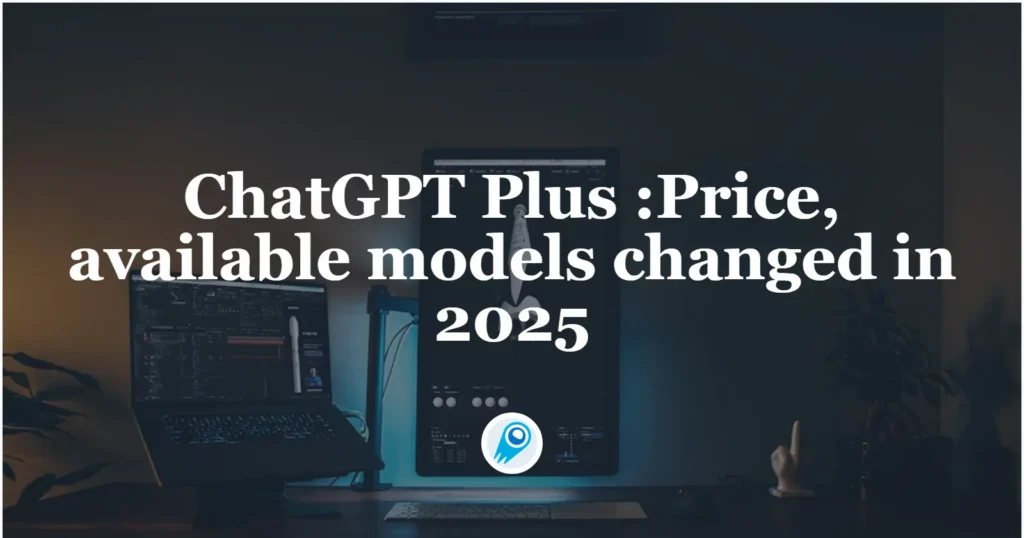ChatGPT Plus: Price, available models changed in 2025

In a fast-moving AI landscape, the dollar figure attached to a subscription can feel both simple and complicated. At face value, ChatGPT Plus remains a single-line item on many budgets: a monthly subscription that grants faster responses, priority access to features, and use of OpenAI’s advanced models. But the story around price — what you get for it, how regional plans are being adjusted, and signals about future increases — has shifted several times in 2024–2025.
How much does ChatGPT Plus cost?
ChatGPT Plus is commonly quoted as \$20 per month for individual users in major markets, the price OpenAI announced when the plan launched and which has remained the baseline for many countries. That fee grants the “Plus” experience — priority access during peak times, faster responses, and early access to new features — but local pricing can vary by region, and OpenAI sometimes tests regional or promotional offerings.
Is that price absolute worldwide?
No — while \$20/month is the canonical headline price, OpenAI (like other tech companies) adjusts pricing and occasionally launches market-specific tiers or promotions. For example, OpenAI introduced a lower-cost product lineup for certain markets (such as the India-targeted ChatGPT Go offering) that changed the local price/performance tradeoff in 2025; these localized offers are part of a broader strategy to balance affordability and access in large markets.
Why have people been talking about ChatGPT Plus price recently?
A cluster of changes and announcements in 2025 has pushed pricing into public view. Two threads are most important:
- Product access changes tied to subscription tiers. OpenAI removed access to a much-loved model (GPT-4o) from the free tier and restricted it to paying subscribers — a move reported in August 2025 that effectively put the capabilities of that model behind the \$20/month paywall. That decision sparked backlash because users who’d grown fond of GPT-4o’s behavior suddenly needed to subscribe to keep using it.
- New, lower-cost regional plans (and product complexity). OpenAI has also been quietly experimenting with additional subscription flavors — for example, a lower-cost ChatGPT Go plan appearing in limited regions and priced at roughly 399 INR (≈\$4–5/month) in India, according to reports. That suggests a more tiered pricing strategy: keep a feature-rich Plus plan around \$20 while offering cheaper, region-targeted options for broader reach.
Which Models Can ChatGPT Plus Users Access (August 2025)
1. GPT-5 (Unified Model)
For Plus subscribers, the most prominent model is GPT-5, released in August 2025. This model is now the default choice in ChatGPT and represents the highest level of capability OpenAI offers to non-enterprise users. GPT-5 adapts its behavior depending on the complexity of the request: it can respond almost instantly for light, everyday interactions, but it can also shift into a deeper reasoning mode when handling more difficult prompts such as multi-step planning, coding challenges, or mathematical proofs. Because of this adaptive nature, it is equally effective for casual conversation and advanced technical work. Plus users in particular benefit from priority access to GPT-5, ensuring fast availability even at peak times, along with higher usage limits that allow for more extensive sessions.
Plus users enjoy higher usage limits for GPT-5 compared to free users. They can also manually select “GPT-5 Thinking” via the model picker.
Key Features:
- Adaptive reasoning: Can automatically switch between fast response mode and deep reasoning mode depending on the task.
- High accuracy across domains: Strong performance in writing, coding, math, logical reasoning, and multi-step planning.
- Improved safety and reliability compared to GPT-4 and GPT-4.1.
- Best suited for: General-purpose high-quality conversations, advanced problem-solving, long-form writing, and creative work.
2.GPT-4o (Omni Multimodal Model)
The multimodal GPT-4o has remained one of the most popular models for ChatGPT Plus users. GPT-4o is designed to handle not only text but also images and audio, which makes it especially valuable when tasks involve visual analysis or cross-modal reasoning. Users often turn to GPT-4o when they need a faster, more responsive model, or when they want to blend text and image inputs seamlessly. Although GPT-4o was briefly removed from the platform after GPT-5 launched, user demand brought it back into the model selector, and it now once again serves as an alternative to GPT-5 for those who prioritize speed and multimodal flexibility.
Key Features:
- Accepts text + image inputs directly in ChatGPT.
- Known for being faster and more responsive than earlier GPT-4 models.
- Popular among users for casual use, brainstorming, and tasks that mix visuals with text.
- Best suited for: Image analysis, multimodal conversations, and creative brainstorming that requires speed and flexibility.
2. GPT-4.1
The GPT-4.1 series represents an evolutionary step beyond the original GPT-4, optimized to balance speed, cost, and reasoning ability. Within this family, smaller variants like GPT-4.1 nano are extremely fast and lightweight, while the full GPT-4.1 model provides reasoning performance close to what GPT-4.5 once offered, but with greater efficiency.
GPT-4.1 Family: GPT-4.1, GPT-4.1 mini, GPT-4.1 nano
- Released in April 2025, GPT-4.1 and its lightweight variant GPT-4.1 mini are available to ChatGPT Plus users through the “More Models” picker.
- GPT-4.1 is particularly strong for coding and instruction-following tasks.
3. The “o-series” Reasoning Models
Although GPT-5 is standard, ChatGPT Plus users still have access to specialized “o-series” models for intensive reasoning tasks: o3, o4-mini, o4-mini-high, and o3-pro that aimed at advanced reasoning and technical tasks like math, coding, visual analysis.
Plus users previously had limits such as ~100 messages per week on o3, 300/day on o4-mini, etc.However, with GPT-5 now dominant, actual usage of these o-models may be less common, though they remain available.
4. The Changed state of GPT-4.5 (updated August 2025)
GPT-4.5, released in February 2025, was initially made available to ChatGPT Pro users and developers under flexible rate limits, though API access was costly—around $75 per million input tokens and $150 per million output tokens. It was praised for fluency, emotional intelligence, and fewer hallucinations, but users found only modest improvements in reasoning compared to GPT-4o. By April, OpenAI began deprecating the gpt-4.5-preview API, fully retiring it in July. On August 7, 2025, OpenAI released GPT-5 and announced that GPT-4.5 had been removed and was no longer available through the ChatGPT website or API.
However, a recent change occurred: About two weeks ago, Sam Altman stated that in response to user feedback, GPT-4.5 had been re-released, but only available to Pro users. This access required enabling “Show additional models” in the ChatGPT settings.
Summary of the timeline in English:
• Feb 27, 2025 – GPT-4.5 is officially launched. Access is rolled out first to Pro subscribers, then to ChatGPT Plus and Team plans.
• Jul 14, 2025 – The GPT-4.5 API is discontinued, although the model remains usable on the ChatGPT platform.
• Aug 7, 2025 – GPT-5 is released, and GPT-4.5 is temporarily removed from ChatGPT.
• Mid-Aug 2025 – GPT-4.5 is re-enabled in ChatGPT, but only for Pro users via the “Show more models” toggle.
Visual Overview
| Model / Series | Status for Plus Users | Best For |
|---|---|---|
| GPT-5 (Auto, Fast, Thinking) | Default model; full access | General-purpose — creativity, coding, reasoning |
| GPT-5 Pro | Pro only | Highest accuracy in complex, technical tasks |
| GPT-5 Thinking mini | Plus (after limit exceeded) | Continued access to reasoning at lower cost |
| GPT-4o | Legacy model | Multimodal conversations, visual/audio inputs |
| o3 / o4-mini / o4-mini-high / o3-pro | Legacy (via toggle) | STEM, coding, visual/analytical tasks, deep reasoning |
| GPT-4.1 / mini / nano | Legacy (toggle) | Coding-heavy, long documents, app/tool integration |
| GPT-4.5 (Orion) | Pro only | — |
How to Enable Legacy Models in ChatGPT Plus
- Open ChatGPT in your web browser (desktop).
- Click your profile icon (bottom left corner).
- Navigate to Settings (or Workspace Settings if you’re using a managed workspace).
- Find and toggle on“Show additional models” (sometimes still labeled as “Show legacy models”).
- This reveals legacy options such as GPT-4o, GPT-4.1, o3, and o4-mini.
- Pro accounts may see even more (e.g., GPT-4.5)
Once enabled, these models appear in your model picker under a separate “Legacy models” or “Additional models” section, accessible when starting a new chat or switching models in an existing conversation.
What are the quotas for ChatGPT Plus?
GPT-5 (ChatGPT)
Plus users: can send up to 160 GPT-5 messages every 3 hours before the chat falls back to a mini variant. Plus/Business can also manually select the GPT-5-Thinking variant; that variant carries a separate weekly allowance (GPT-5 Thinking: 3,000 messages per week (up from 200, a significant increase), after which it will switch to the GPT-5 Thinking mini model). OpenAI’s GPT-5 in ChatGPT page gives these usage figures.
OpenAI o3 / o4-mini family (interactive)
ChatGPT Plus (and Team/Enterprise) account holders have e.g. 100 messages/week for o3, 100 messages/day for o4-mini-high, and 300 messages/day for o4-mini (these are the per-day/week limits OpenAI publishes for those model variants in ChatGPT). When a limit is reached the model becomes unselectable until the rolling window resets.
GPT-4o / GPT-4 variants
OpenAI has historically used rolling limits expressed in “messages per 3 hours” (It has been re-enabled as a core working model by default.).The original message limit remains approximately 80 messages per 3 hours, while the limit for GPT-4 is 40 messages per 3 hours.
File Upload Limits
Plus users can upload up to 80 files every 3 hours. This limit operates on a rolling basis, meaning your quota is continually replenished.There is a separate quota of 50 images per day
Per-File Size Limits (by type):
The general hard limit for single file uploads is 512MB. This applies to most document and presentation formats. However, for text-intensive files like PDF and DOCX, there’s a different limit: a limit of 2 million tokens. Since a token represents part of a word, this limit roughly translates to 500,000 words, which is sufficient for most books and long reports.
Spreadsheets (such as CSV or XLSX files) have a practical size limit of approximately 50MB. Similarly, image files used for visual analysis are limited to 20MB per file.
Storage Limits:
- 10 GB total storage per Plus account (across chats and uploaded files) .
- Organization accounts (Enterprise/Team): Up to 100 GB storage .
Deep Research Quota
ChatGPT Plus users get:10 full Deep Research queries per 30 days (powered by the full o3 model)Plus an additional 15 lightweight queries (powered by o4-mini) once the full-model quota is used. This totals 25 Deep Research uses per month for ChatGPT Plus subscribers.
What extended functions does Plus get compared with the Free tier?
1. Expanded Usage Limits & Priority Access(GPT-5): ChatGPT Plus users enjoy significantly higher message quotas with GPT-5 (e.g., GPT-5 Thinking mode, up to 3,000 messages/week plus mini-model fallback) and experience reduced throttling or wait times when usage is heavy. The free tier faces stricter usage caps and slower throughput during traffic peaks. Plus unlocks three GPT-5 performance modes: Auto (the system chooses), Fast (prioritizes speed), and Thinking (deep reasoning). Free users generally use only Auto or a simplified fallback—Plus gives you more control and nuance.
2. Agent Mode (Autonomous Task Execution): Agent Mode lets ChatGPT carry out multi-step operations on your behalf—like browsing, form-filling, data collection, document creation, and workflow automation. It functions like an AI assistant doing the task, not just giving advice. Free users cannot access this at all.
3. Deep Research (Autonomous Web-based Report Generation): The Deep Research agent performs autonomous, web-based research to generate expert-level, cited reports over several minutes. ChatGPT Plus users get up to 25 Deep Research queries per month (10 full-model + 15 “lightweight”), compared to only 5 lightweight queries for Free users.
4. Voice, Video & Collaboration Enhancements: ChatGPT Plus users unlock advanced voice interactions with tone customization and smoother speech. It also supports collaborative and media-rich features like video (e.g., “Sora” or screensharing), shared workspaces, and integrated voice/video modes. Free users have basic voice and no such collaborative tools.
5 .Integration with External Services (Gmail, Calendar, Microsoft Connectors): GPT-5 brings integration with Gmail, Google Calendar, and Microsoft services (Teams, GitHub via “Connectors”), letting ChatGPT assist with scheduling, email context, and workplace tools. Plus users gain early or exclusive access to these integrations.
6. Custom GPTs and Codex: ChatGPT Plus (and Team/Enterprise) can create custom GPTs (the GPT Builder) and publish to the GPT Store; Free users can use some public GPTs but generally cannot create GPTs. This is important if you want to build a repeatable, production workflow inside ChatGPT.You can access the codex,Average users can send 300-1,500 messages every 5 hours with a weekly limit.
Practical tips for Plus users (how to get the most for your $20)
Use smaller models for drafts (GPT-4o-mini / o4-mini) and switch to GPT-5/GPT-4o only for final-generation or heavy reasoning. This conserves your message quota on premium models.
Pool Deep Research queries: plan big research requests into one job rather than many small ones (Deep Research jobs are expensive in allotment).
Build a custom GPT for repeated workflows — it offloads repetitive prompt engineering into a reusable agent and avoids spending premium-model messages for boilerplate. (Plus enables GPT Builder.).
Track model caps in practice — the UI uses rolling windows (e.g., 3-hour windows). If you get blocked, wait for the rolling window to move (or switch to a cheaper mod
Final verdict: who should pay \$20/month for ChatGPT Plus?
ChatGPT Plus is a straightforward, well-priced upgrade for professionals, frequent users, and students who can access temporary promotions. If you derive measurable productivity gains from faster responses, lower downtime, or early access to models that materially improve outputs, \$20 a month is a reasonable investment. For casual users or those primarily interested in very specific integrations that are currently gated to higher tiers, API may be a better match.
Getting Started
CometAPI is a unified API platform that aggregates over 500 AI models from leading providers—such as OpenAI’s GPT series, Google’s Gemini, Anthropic’s Claude, Midjourney, Suno, and more—into a single, developer-friendly interface. By offering consistent authentication, request formatting, and response handling, CometAPI dramatically simplifies the integration of AI capabilities into your applications. Whether you’re building chatbots, image generators, music composers, or data‐driven analytics pipelines, CometAPI lets you iterate faster, control costs, and remain vendor-agnostic—all while tapping into the latest breakthroughs across the AI ecosystem.
Developers can access GPT-5, GPT-4.1, O3-Deep-Research, o3-Pro etc through CometAPI,the latest model version is always updated with the official website. To begin, explore the model’s capabilities in the Playground and consult the API guide for detailed instructions. Before accessing, please make sure you have logged in to CometAPI and obtained the API key. CometAPI offer a price far lower than the official price to help you integrate.



